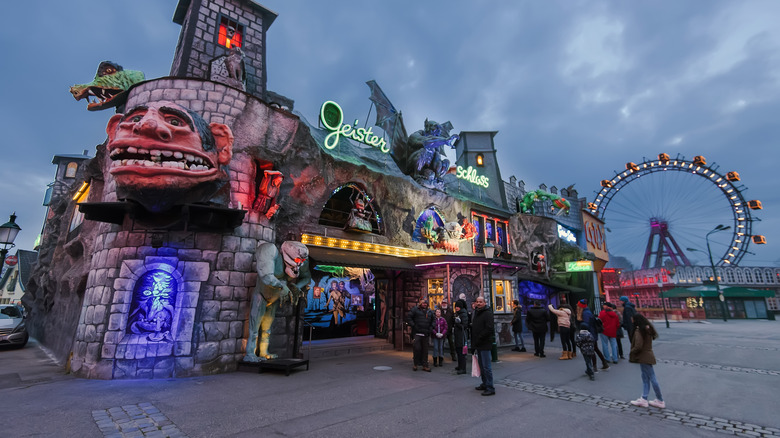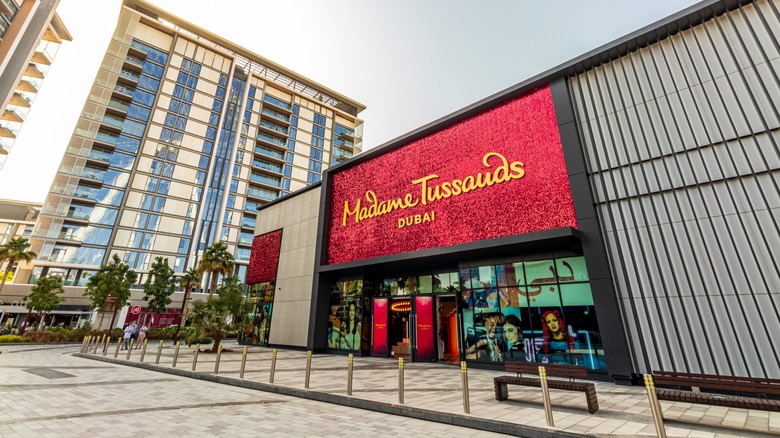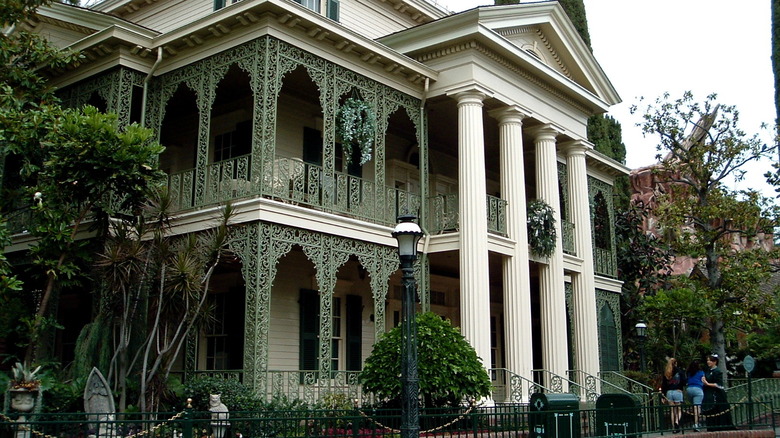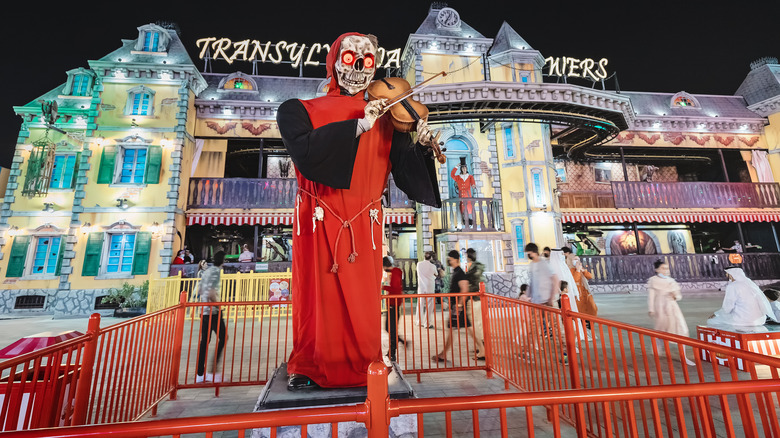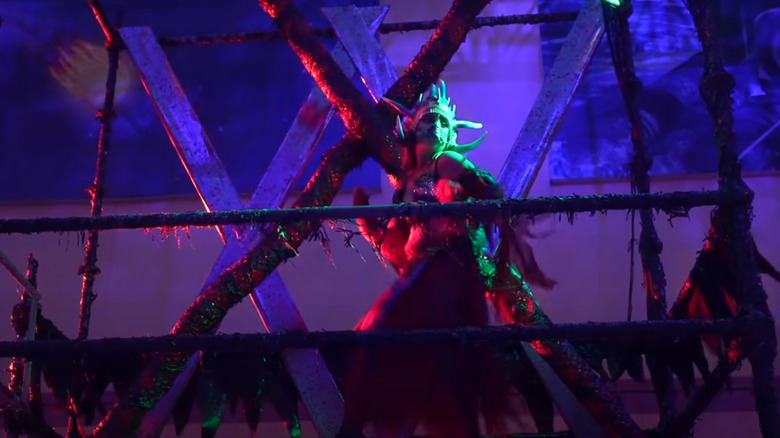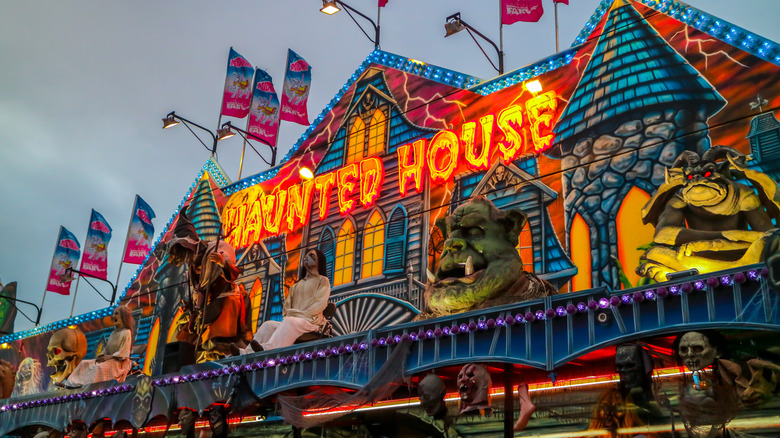The Origin Of Haunted Houses Is Older Than You Think
It's that time of year! Halloween, or "Spooky Season," as it's come to be known. Halloween is big business here in the U.S.; according to Finical Holdings, the holiday saw about $8.8 billion spent on candy, costumes, props, and such in 2020.
This is also the season when Americans stand in line for hours to experience haunted house attractions — specifically, an experience that you pay for to walk through various settings and get scared by costumed actors (as opposed to places where people live (or lived) that are supposedly bedeviled by the supernatural).
Haunted house attractions are huge in the U.S. and elsewhere. According to America Haunts, there are an estimated 1,200 standalone haunted attractions here, and another 300 that are attached to an existing business, such as a theme park. Thousands of people will visit them over the course of a year. Though this may seem like a recent trend, the idea of paid haunted house attractions actually goes back several decades.
Madame Tussaud and the Grand Guignol
If you've ever been to Las Vegas or another major city that relies on tourism, you've no doubt been to, or at least walked past, a Madame Tussauds Wax Museum franchise, wherein you can see lifelike wax representations of your favorite celebrities or historical figures. The business dates back to 1802 London, according to Smithsonian Magazine, when the actual Madame Marie Tussaud created lifelike wax figures based on the death masks of individuals who had met the guillotine during the French Revolution. The attraction scared Londoners half to death, setting the stage for the idea of charging money to scare customers.
A century or so later, a Parisian businessman got in on the act via the Grand Guignol Theater. The nightly performances were gruesome in the extreme, even when viewed through the lens of modern sensibilities. "The Grand Guignol would bring the ugliest, nastiest and most brutal stories to its audiences," notes Birth Movies Death, and would "entertain" audiences with graphic depictions of dismemberment and other gruesome fates. (Fake) blood, eyeballs, intestines — any and all of it would wind up on stage on any given night. Terrified Parisians passed out in droves, and kept paying to come back for more. That is, until it closed in 1962 (per The Straight Dope).
Walt Disney enters the mix
The first haunted attractions in the U.S. (putting aside carnival dark rides and such, which date to 1915, according to Smithsonian Magazine) began appearing around the time of the Great Depression. In those days, children didn't trick-or-treat so much as just trick, engaging in acts of vandalism and mayhem, and cities were keen to keep them occupied on Halloween night. Some parents took to designing their own miniature haunted attractions, in basements or garages, and the children would go from house to house.
However, it was in the 1960s that the idea of a haunted house attraction, with paid admission, really got going, and Walt Disney is to thank for that. The showman was known to be obsessed with death, per USA Today, and he was keen to have a haunted attraction in his theme park, Disneyland. The concept went through several revisions, but what he wound up with is the Haunted Mansion (above), which utilizes ancient stagecraft techniques to give the illusion of floating ghosts, busts that appear to follow guests with their eyes, (mechanical) jump-scares, and so on. It's tame compared to modern scare attractions, and there are no living actors whose job is to jump out and terrify guests. Nevertheless, the industry points to this as one of its key turning points. "A lot of the professional haunters will point to one thing, and that's Disneyland's Haunted Mansion. It's the start of the haunted attraction industry," said author Lisa Morton (via Smithsonian).
The Jaycees take things to the next level
Within a few years of the Haunted Mansion's debut (and wild success) at Disneyland, other theme parks were experimenting with the idea. In the 1970s, according to Smithsonian Magazine, Knott's Berry Farm in Southern California began hosting scary attractions on Halloween night and, over the years, expanded the concept to a weeks-long event, Knott's Scary Farm.
But it was a community-betterment group, the Junior Chamber of Commerce (or Jaycees), that is largely responsible for bringing haunted attractions out of theme parks and into American cities. The group raised money by charging people money to be scared and using volunteers to do the scaring. At around the same time, some Christian groups hit upon the idea of using the concept to scare participants into converting, through anti-Halloween settings. None other than the late televangelist Jerry Falwell, for example, via his Liberty University, had a "Hell House" operating its "Scaremare" program (via Charisma News). A key difference between Disneyland's Haunted Mansion (or any other theme park dark ride) and a modern haunted attraction is the addition of live actors, often costumed in gruesome and terrifying garb, who scare customers by chasing them, screaming at them, and/or brandishing (fake) weapons.
Two types of haunted attractions
It helps to think of modern-day haunted attractions as belonging in one of two categories: the theme-park-adjacent and the stand-alone. The concept is still going strong at Knott's Berry Farm 50 years later, and Undercover Tourist calls it the "industry standard" and "the largest Halloween event in Southern California." However, the Universal theme park brand may take exception to at least one of those claims: Halloween Horror Nights (above) takes place at all four of the brand's theme park locations, and to say it's huge is an understatement. Smaller-scale theme park franchises also lean into this seasonal attraction; "fright fests" and the like can be found at Six Flags, Cedar Point, and others.
Year-round, permanent haunted attractions can be found in tourist cities such as Kissimmee, Florida (Mortem Manor) and Niagara Falls, Ontario. In cities such as New Orleans (The Mortuary) or Atlanta (Netherworld), big-name haunted attractions aren't year-round, but start taking reservations as early as August. Seasonal haunted attractions pop up every year at this time, including in towns as small as Potosi, Missouri (population: about 2,000).
This remains (mostly) an American phenomenon
Paid haunted house attractions are almost an exclusively-American phenomenon. And we know this because Sithon, a company that manages actors for haunted attractions, crunched the numbers and concluded that Canada has 51 such attractions, Europe (all of it combined) has 11, Australia has two, and Mexico and New Zealand each have one (as of August 2021), while the U.S. has a couple thousand. Of course, this leaves out theme park-adjacent seasonal haunted attractions at overseas Universal and other theme park franchises. The U.K. boasts a half-dozen Dungeons fright site franchises in London, York, and elsewhere.
Why has America leaned into this concept so heavily? Largely because the U.S. is culturally Christian and adopted many of its holiday and other traditions from Europe, which is also (largely) culturally Christian and in which Halloween (or All Hallow's Eve or Samhain) emerged, according to Sithon. And while Halloween has been around in Europe for centuries, the holiday got big here in the States through a combination of factors that didn't find purchase in Europe. That, and of course, this is America, where if it's worth doing, it's worth overdoing.
